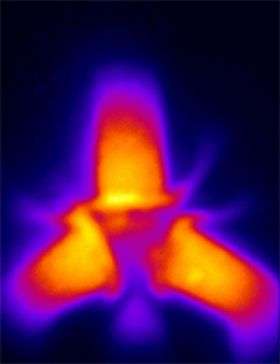Exciton-based circuits eliminate a 'speed trap' between computing and communication signals

Particles called excitons that emit a flash of light as they decay could be used for a new form of computing better suited to fast communication, physicists at UC San Diego have demonstrated.
Integrated circuits, assemblies of transistors that are the building blocks for all electronic devices, currently use electrons to ferry the signals needed for computation. But almost all communications devices use light, or photons, to send signals. The need to convert the signalling language from electrons to photons limits the speed of electronic devices.
Leonid Butov, a professor of physics at UCSD, and his colleagues at UCSD and UC Santa Barbara have built several exciton-based transistors that could be the basis of a new type of computer, they report this week in an advance online version of the journal Science. The circuits they have assembled are the first computing devices to use excitons.
"Our transistors process signals using exitons, which like electrons can be controlled with electrical voltages but unlike electrons transform into photons at the output of the circuit," Butov said. "This direct coupling of excitons to photons bridges a gap between computing and communications."
Excitons are created by light in a semiconductor such as gallium arsenide, which separates a negatively charged electron from a positively charged "hole." If the pair remains linked, it forms an exciton. When the electron recombines with the hole, the exciton decays and releases its energy as a flash of light.
Butov and his colleagues have used a special type of exciton where the electron and its hole are confined to different "quantum wells," separated by several nanometers. This configuration creates an opportunity to control the flow of excitons using voltage supplied by electrodes.
These voltage gates create an energy bump that can halt the movement of excitons or allow them to flow. Once that energy barrier is removed, the exciton can travel to the transistor output and transform to light, which could be fed directly into a communication circuit, eliminating the need to convert the signal. "Excitons are directly coupled to photons, which allows us to link computation and communication," Butov said.
Others involved in the discovery were Alex High and Ekaterina Novitskaya at UC San Diego, and Micah Hanson and Arthur Gossard at UC Santa Barbara.
The scientists created simple integrated circuits by joining exciton transistors to form several types of switches that accurately direct signals along one or several pathways. Because excitons are fast, the switches can be flipped quickly. Switching times on the order of 200 picoseconds have been demonstrated so far. (A picosecond is one trillionth of a second). While exciton computation itself may not be faster than electron-based circuits, the speed will come when sending signals to another machine, or between different parts of a chip that are connected by an optical link.
The circuits Butov and his colleagues have created demonstrate that excitons could be used for computing, but practical applications will require the use of different materials. The gallium arsenide excitonic circuits will only work at frigid temperatures - below 40 degrees Kelvin (or -390 degrees Fahrenheit), a limit determined by the binding energy of the excitons. (Warmer than that, and the electrons won't bind with their holes to form excitons in this structure). The operating temperature can be increased by choosing different semiconductor materials, the scientists said.
Source: University of California - San Diego





















